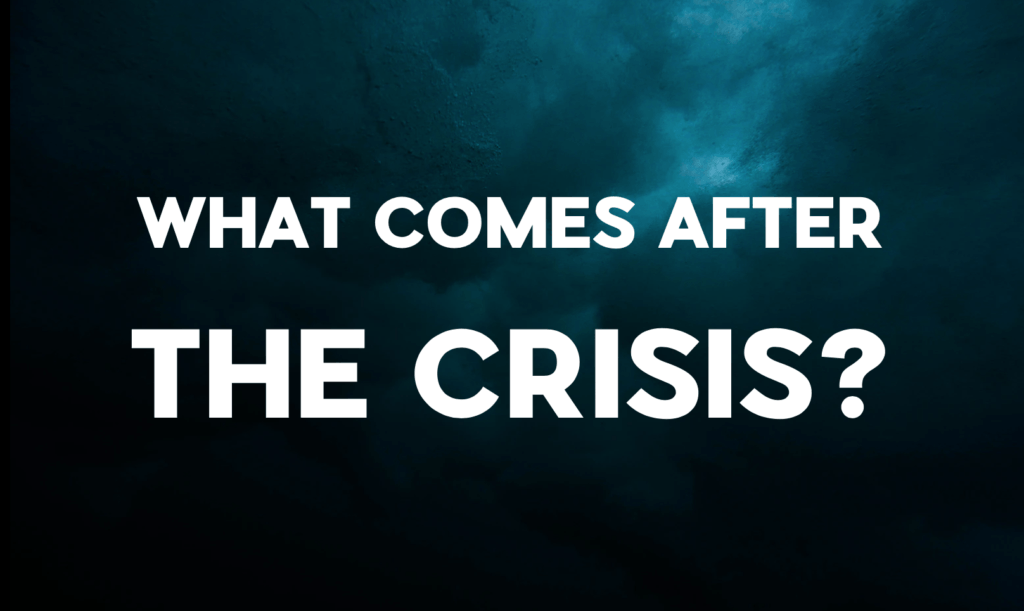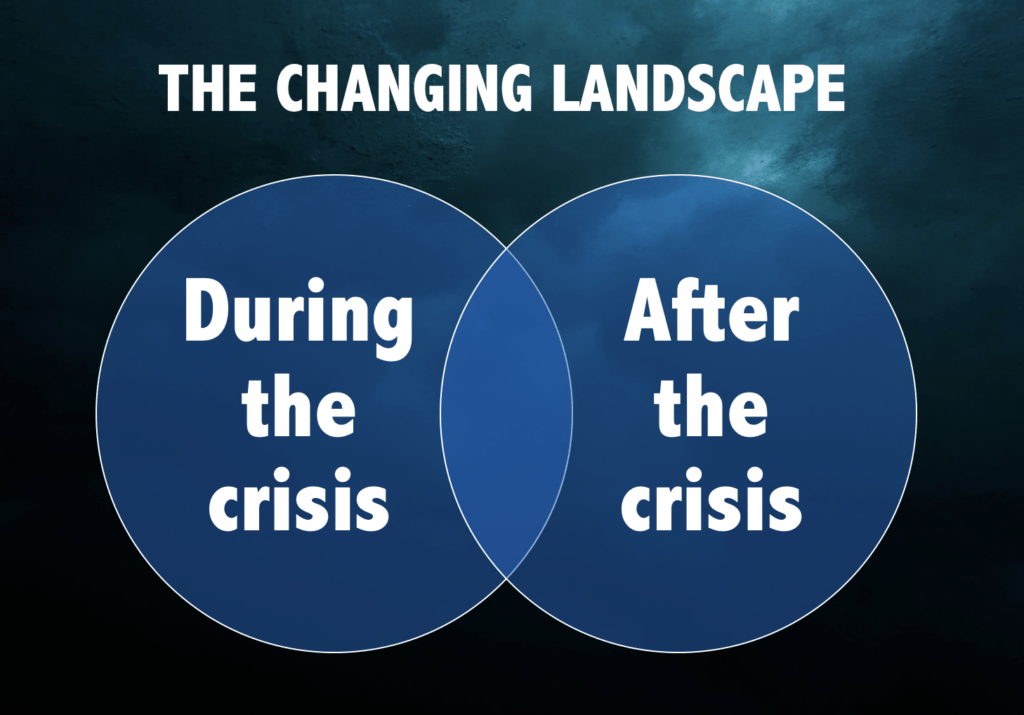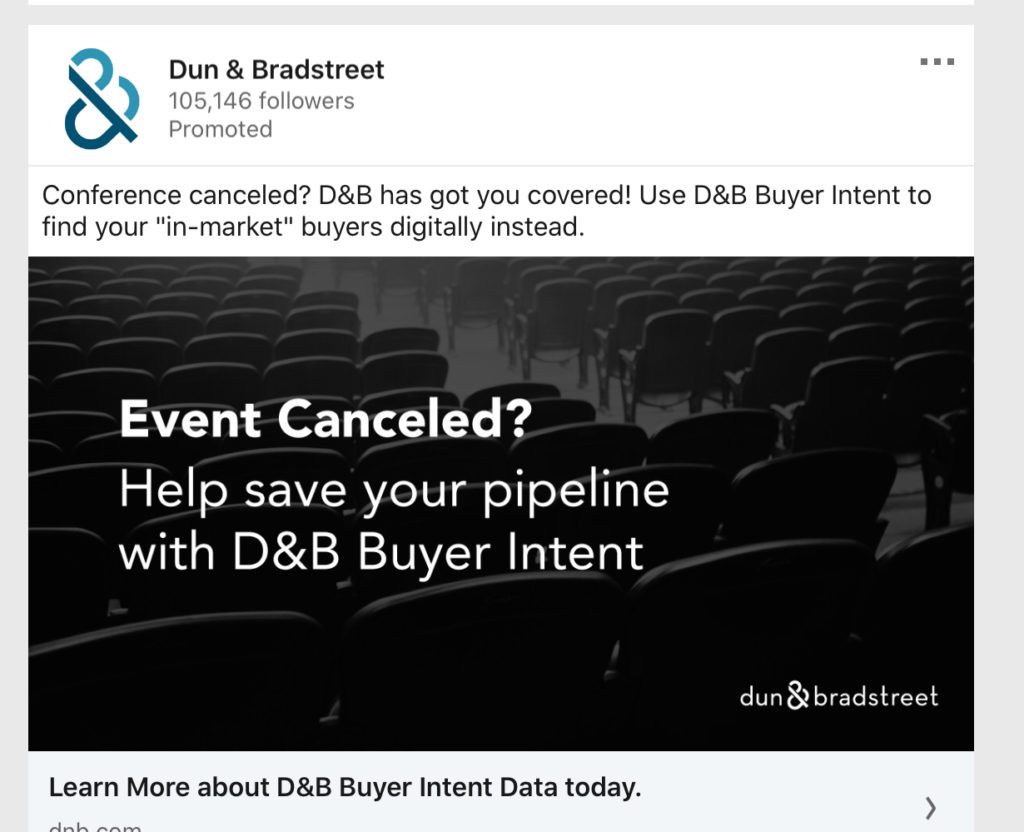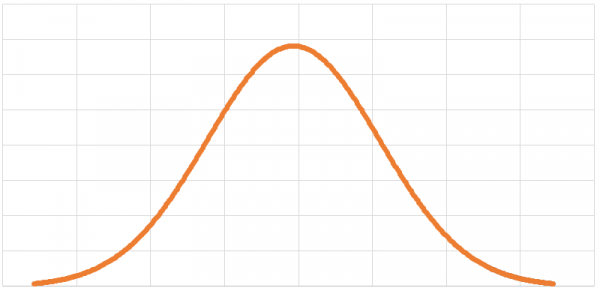
Anybody running a business right now should have only one goal in mind: to arrive on the other side in one piece. By my definition of success, that would be an exceptional success!
There is so much uncertainty in the world right now. The writer George Saunders has a fitting analogy for the current Covid-19 moment: We’ve slipped on ice but haven’t hit the pavement yet. We’re caught in a suspended state between losing control and feeling the full impact.
If that sounds like you, I’m here to help you today. Nobody can predict the future, but we can make reasonable assumptions and plan with the best information we have to set the stage for a world after the crisis.
Today I’ll share a planning process that I’m using with my clients.
Two phases of the crisis
First, you have to understand there are really two distinct phases to this crisis:

Because I’ve already written extensively about strategy “during the crisis,” today, I’m going to focus on this second phase — after the crisis.
To review, my definition of “during the crisis” is when people are:
- constrained from normal life activities,
- concerned about addressing basic human needs,
- adopting consumer behaviors and routines that will eventually dissipate after the crisis
The primary goals during this phase are (with links to blog posts to help you):
- Apply your core business competencies to what is relevant now
- Move to where your customers are in terms of their foundational needs
- Consider opportunities to serve in short-term ways that create long-term loyalty
- Conserve cash, re-tool budgets, and pivot as needed to fight to the other side
“After the crisis” will certainly be a new normal forced on us by the shifting consumer habits and economic realities of the crisis. As the chart above suggests, there will be overlapping changes between the two phases.
The new normal after the crisis will be characterized by altered work and lifestyle habits even when the crisis restrictions have been lifted. These habits may change due to:
- Permanent new choices learned and adopted during the crisis phase (like a focus on in-home cooking, new home entertainment traditions, home delivery, or sanitizing habits)
- Old options that aren’t available any longer (like going to a favorite restaurant or music venue that didn’t make it through the crisis)
- Behavior changes that evolve due to innovations that occurred during the crisis (like better work-from-home options)
- Choices forced by dramatic changes in personal income and global economic conditions
So as we look toward the future, we need to think through where our customers are likely to be and how our business must change to be in the right place at the right time for them.
Waking up the customers
My friend Martin Lindstrom, the excellent business strategist and author of Small Data: The Tiny Clues That Uncover Huge Trends also suggests there might be a third, interim phase: Waking up customers.
Martin projects that in the event of a prolonged lock-down period, customers will be sluggish in returning to traditional consumer habits. Your business might need to engage in marketing activities that “wake people up” from their new habits and remind them of their choices.
An example might be vacation travel. If people have been so conditioned to not consider vacation plans, marketers might need to create fun experiences to remind people that they are free to move about the country and the world.
“After the crisis” strategy
Based on nearly every economic projection, the “new normal” may last for years … at least until people feel safe enough to be in crowds and they have the money to spend on their beloved pre-crisis activities.
So the timing of these phases is fluid. We may be in the post-crisis phase and then re-enter another crisis phase if the coronavirus returns in waves, for example.
Despite this uncertainty, it’s possible and necessary to start thinking through the implications and new strategies now.
There are four main business considerations to explore when thinking through the post-crisis new normal:

Let’s explore these ideas.
1. Changes in customer needs and habits
Is your customer base still going to be there on the other side? Here are some of the questions you need to debate:
- How will spending patterns change?
- Will there be pent-up demand?
- Will customers be buying through the same channels?
- Will new crisis habits stick or will things go back to normal?
- Has a new competitor emerged (or an old one crash) during the crisis?
Example: I’ve been working with a client that serves major museums, parks, and theaters. Here’s the good news — their customers will be there on the other side. But the bad news is that their funding from ticket receipts, donors, and tax revenues will evaporate. So she will have customers, but the customers will have no money. I’m encouraging her to involve lenders to look at creative new funding options.
Another example. My wife and I have discovered that we enjoy cooking home-delivered meal kits through Hello Fresh. We’ve learned cost-effective new recipes and enjoy a variety of healthy dishes that have replaced eating out. We’ll continue this tradition after the crisis. We’re eating through an entirely different channel we never considered before.
2. Relevance of core competencies
After you’ve thought through the customer situation, you have to consider whether your core competencies still match the new customer needs.
A very relevant example in my life — college education.
During the coronavirus crisis, all of my in-person college classes were canceled. In the short-term, the college didn’t have a viable option to move to an online environment. Now, online learning is becoming routine.
Will this stick?
Many universities have not had a robust core competency in general online learning. Walking to class across a beautiful campus and interacting with live faculty members in a classroom has been the norm for centuries.
If online learning becomes the norm, colleges will have to invest a lot more in IT and IT professionals. They’ll have to re-organize to support new core competencies.
Will your core strengths still be aligned with market needs? Is this the time to invest in new capabilities?
3. Disconnects in the selling model
Before the coronavirus grounded me, I gave a speech to an association group in California. The trade floor was jammed with interesting vendors displaying everything from software to personal services.
I always like to walk the floor and learn new things and one display in particular caught my attention. I asked the sales representative how much of their total business came from trade shows and he said, “Almost all of it. This is where we see our customers face-to-face every year and sign our new annual contracts.”
A lot of the business world depends on the traditions of face-to-face interactions. For me, a high percentage of my new business comes from being seen on a stage somewhere.
What happens if face-to-face networking doesn’t make it to the new normal? For B2B, trade shows are virtually tied for first with email and websites for engagement of new prospects. And they’re the most frequently cited source of deals that actually close, according to eMarketer.
I think this is a serious question for many businesses because I just do not think people are going to rush to crowded conferences and industry events in the short-term. Having to sell almost entirely in a “virtual mode” introduces dramatic new dynamics.
I recently saw this ad from Dun & Bradstreet anticipating this shift:

One of the solutions to this problem that I really love is SoloSegment. They have software to significantly increase the sales yield of your web traffic, primarily for B2B leads.
Many of us will have to find creative new ways to connect and demonstrate our value in the new normal.
4. Expected results after the crisis
I was connecting with a friend this week who works for a large, diverse company. The company is experiencing so many financial upsets right now that any idea of a “budget’ has been thrown out the door.
“Usually in May we’ll re-evaluate and tweak our budget,” he told me. “This year, we’re going to re-write it.”
The corporate world is finally-tuned to achieve ever-improving quarterly results. But the post-crisis world is going to be straddled with
- High levels of consumer, government, and corporate debt
- A shake-out among customer companies and supply chain partners
- Recessionary economic pressures
All of these factors (and more) could put profit expectations into a tailspin.
Before you decide on any significant changes in the business model, you’ll want to think through how the crisis will affect your existing performance metrics. What kind of earnings, or losses, will you encounter? How will your customers and stakeholders judge your organization in the current crisis? How might it affect your reputation?
Thinking in terms of probabilities
I think these four considerations will create the discussion you’ll need in your company to develop a post-crisis vision for your company. But there is one more thing to think about.
During times of chronic uncertainty, we often get stuck imagining extreme outcomes. Leaders who are adept at managing uncertainty think in terms of probabilities instead.
French philosopher Michel de Montaigne’s observed: “My life has been full of terrible misfortunes, most of which never happened.”
Many of the realities of the natural and economic world fit on that classic bell curve we learned about in our first statistics class:

If you can dream up the worst possible scenario and the best possible scenario, they probably belong on the tails of the curve. Problem is, many businesses focus all their effort on the worst case when it is probably a low probability.
For my business, I am trying to find analyses that might point me to the middle of the curve.
For example, McKinsey recently surveyed thousands of business executives and posed nine scenarios describing the economic impact of the crisis and the recovery period. The clearest survey result was the respondent preference for the scenario defined by:
- a (regional) recurrence of the virus after containment,
- a muted recovery
- and slower long-term growth.
The most popular answer from thousands of respondents would represent the peak of the response bell curve. In fact, the top three answers all forecast a slow economic recovery. In the end, this forecast might not be correct — the situation is changing so swiftly — but it gives me a rational target to shoot for.
Obviously I will be continuously on the lookout for more signals as views of the post-crisis world change over time.
So this is the viewpoint and strategy I’m sharing with my clients as we try to envision the post-crisis world. Does it make sense to you? What would you add to my ideas?
Note: I’ve prepared an inspirational, 30-minute virtual presentation designed for weekly team meetings. Filled with inspirational case studies and real-world solutions, it’s called “Fighting to The Other Side”. To learn more, or to bring this to your next meeting, send me a message here.
 Mark Schaefer is the chief blogger for this site, executive director of Schaefer Marketing Solutions, and the author of several best-selling digital marketing books. He is an acclaimed keynote speaker, college educator, and business consultant. The Marketing Companion podcast is among the top business podcasts in the world. Contact Mark to have him speak to your company event or conference soon.
Mark Schaefer is the chief blogger for this site, executive director of Schaefer Marketing Solutions, and the author of several best-selling digital marketing books. He is an acclaimed keynote speaker, college educator, and business consultant. The Marketing Companion podcast is among the top business podcasts in the world. Contact Mark to have him speak to your company event or conference soon.


